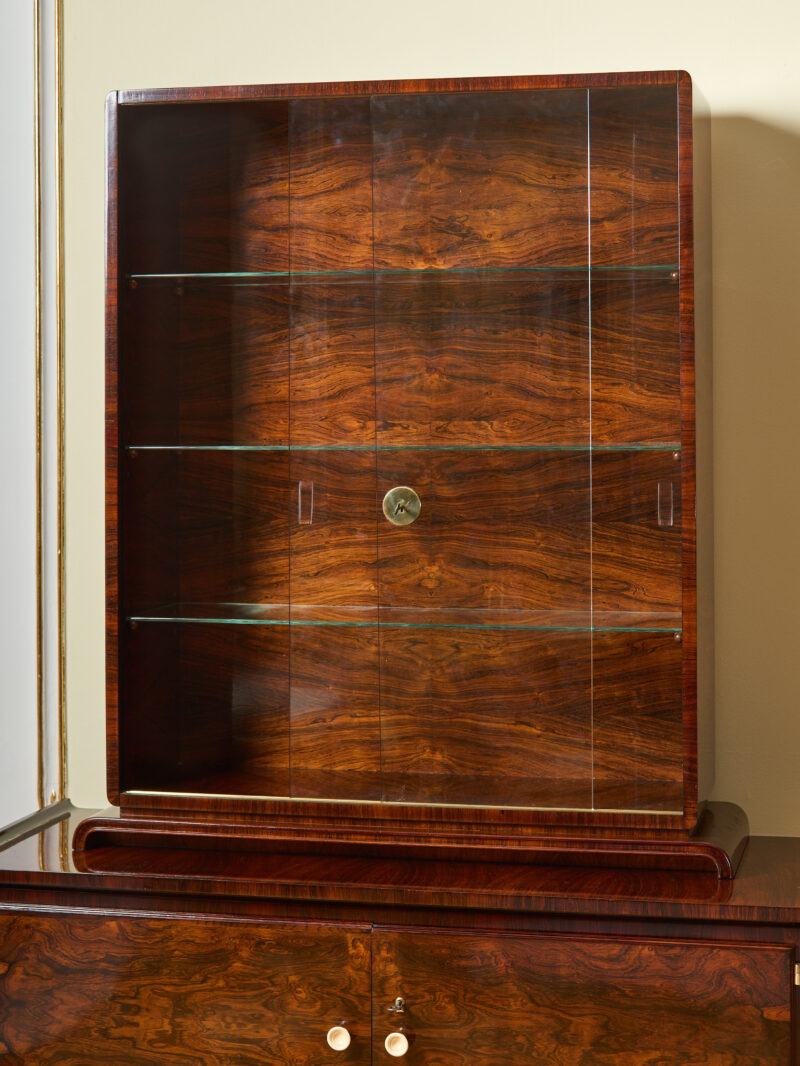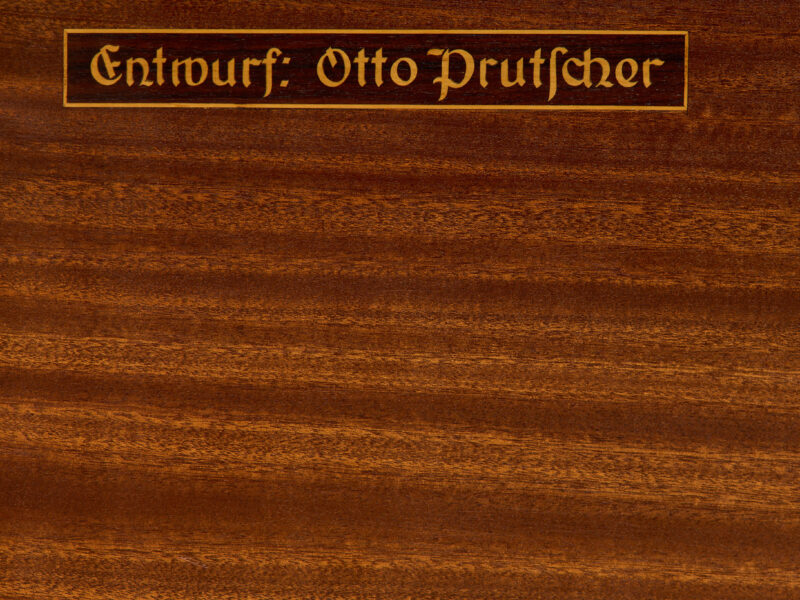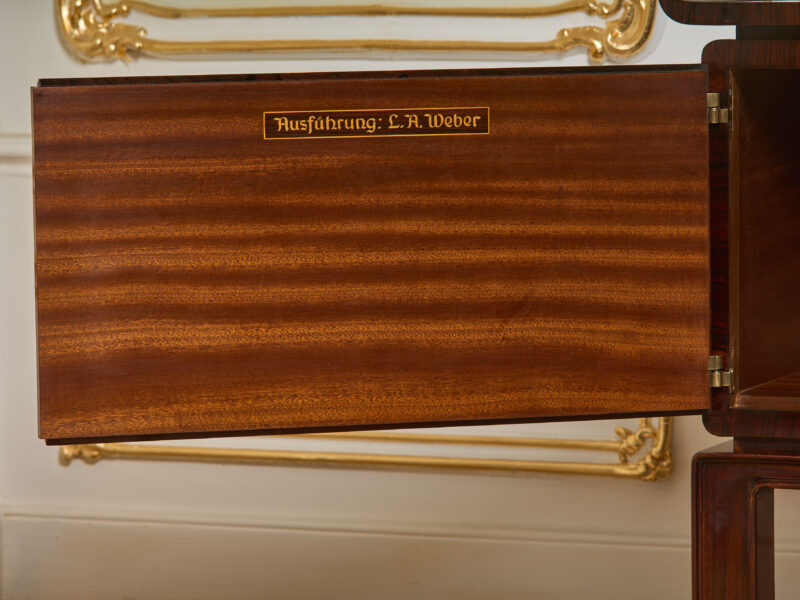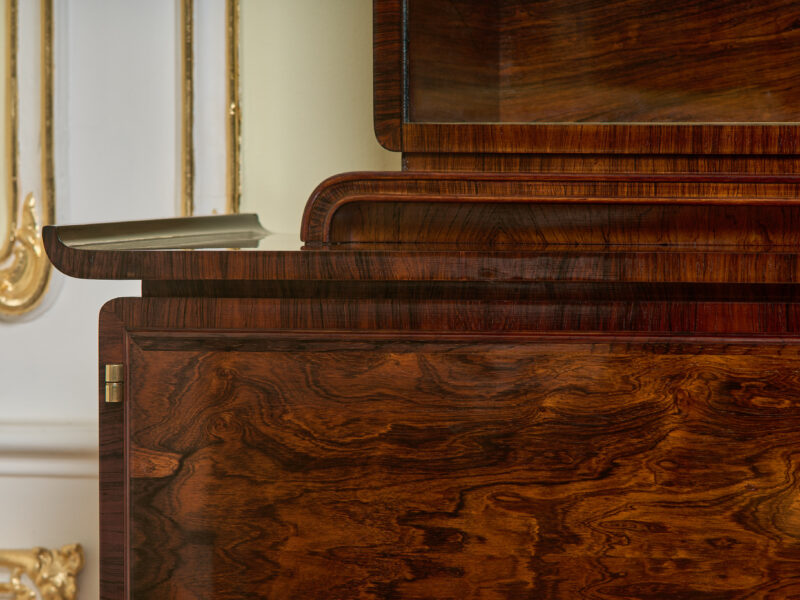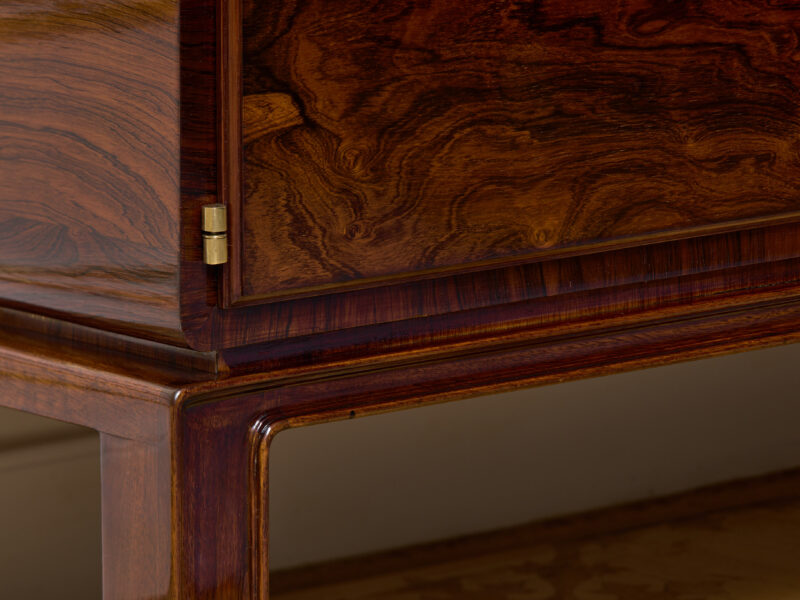
Display Cabinet, Design by Otto Prutscher (1880-1949)
Beautiful design of a display cabinet by Otto Prutscher from the 1930s, for Dr. Hugo Winkler.
The display cabinet and the lower body of the furniture are made in two parts and finely veneered in Caucasian walnut. The display cabinet is equipped with two sliding glass doors, which can be locked with a round, nickel-plated lock, and three glass shelves. The lower body stands on a profiled frame with tall legs. The two doors are equipped with round handles made of bakelite.
On the inside of the two doors, we find an inlaid inscription each stating “Design: Otto Prutscher” and “Execution: L. A. Weber.”
The top plate of the body curves upwards at its lateral ends in a slightly curved form, giving the furniture a delicate Asian influence. The transition from the lower body to the display cabinet is interrupted by a finely profiled base which adds a certain lightness to the furniture.
A beautiful example of a very streamlined piece of furniture, which, through the skillfully incorporated rounded elements, acquires an elegant and almost feminine appearance.
This display cabinet is depicted and described in the 2‑volume collection book by Heim & Fritz Schedelmayer published by the University of Applied Arts Vienna.
“Otto Prutscher 1880 – 1949 Architect and Designer between Traditions and Modernism” Volume 1 Page 266, Illustration 220
For Dr. Hugo Winkler in Vienna XII, Otto Prutscher designed a salon and dining room in 1931, both executed by the carpenter Andreas L. Weber. A display cabinet Fig. 220, two small consoles 425, placed between the windows, three small tables, a daybed, an armchair, and some stools (“Causeusen”) have been preserved as individual pieces of furniture.
On the inside of the display cabinet, the inscriptions “Design Otto Prutscher” and “Execution L. A. Weber” are inlaid. Exactly the same signature along with the year “MCMXXXI” is found on a living room cabinet with a bar section 427 with very complex inlays on the insides of two doors.
Otto Prutscher (1880−1949)
belonged to the first generation of students at the Vienna School of Arts and Crafts. His admission in 1897 and instruction by some of the prominent artists of the Viennese Modernist movement, such as Josef Hoffmann, Koloman Moser, Willibald Schulmeister, and the painter Franz Matsch, profoundly influenced Otto Prutscher’s stylistic development. From 1907 onwards, Otto Prutscher worked for the Vienna Workshops. Like Josef Hoffmann, he was an architect and designer, and like him, he taught at the Vienna School of Arts and Crafts from 1909. He was a member of the most important artists’ associations such as the Vienna Secession, the Vienna Workshops, the Werkbund, and more. He also collaborated with and worked for the most significant Viennese manufactories of his time in various different fields. His incredible productivity in architecture and design makes him one of the greats among Viennese architects and designers. Otto Prutscher was thus significantly involved in the development of Viennese Modernism.
Otto Prutscher was not only a busy architect and one of the leading applied artists in Vienna at the beginning of the 20th century.
In addition to designing some of the large residential complexes in Vienna, he primarily planned private and commercial buildings as well as coffeehouses and their interiors.
He designed interiors for many of Vienna’s wealthy families, which were executed by the most prominent producers of his time, such as Jacob & Josef Kohn, Thonet, Portois & Fix, or J. & L. Lobmeyr. He also designed furniture, porcelain, glassware, cutlery, metalwork, jewelry, watches, book covers, textiles, and more for the Vienna Workshops. His estate, which is now housed in the MAK — Museum of Applied Arts Vienna, includes plans and architectural photographs as well as original designs for furniture and applied art objects.
The museum dedicated its own exhibition to him in 2019/2020 (Otto Prutscher. All Designer of Viennese Modernism, November 20, 2019 — May 17, 2020).
Provenance of the furniture:
From the Schedlmayer Collection. Literature: Otto Prutscher Archive, 1366; Uhlir, Semper Sursum, p. 122; Duit, Schedlmayer, Otto Prutscher, Volume 1, p. 266, No. 220.
The Schedlmayer Collection. A Discovery! 10.09.2021 – 20.02.2022, MAK Vienna
The Austrian collector couple Hermi (1941 – 2018) and Fritz Schedlmayer (1939 – 2013) brought together a top-class selection of arts and crafts objects and works of art from the first half of the 20th century. This largely unknown collection will be presented to the public for the first time in autumn of 2021.
Watch Video I by clicking here, Video II here.
